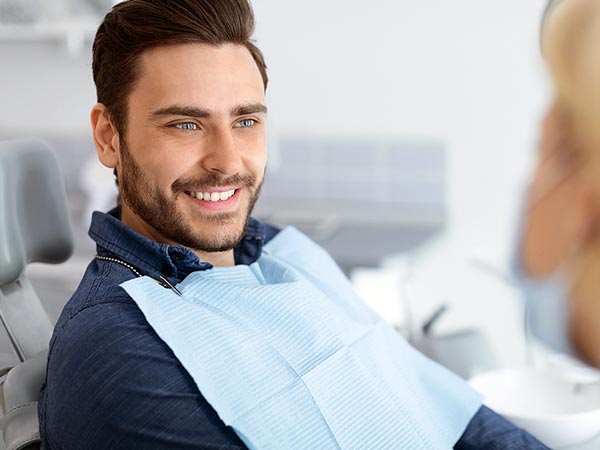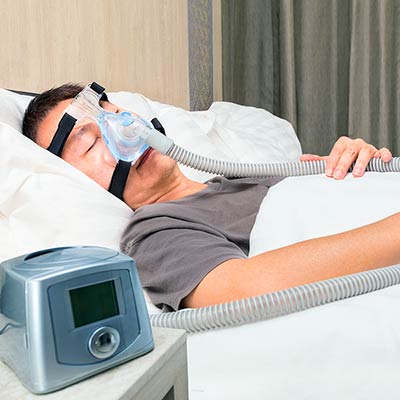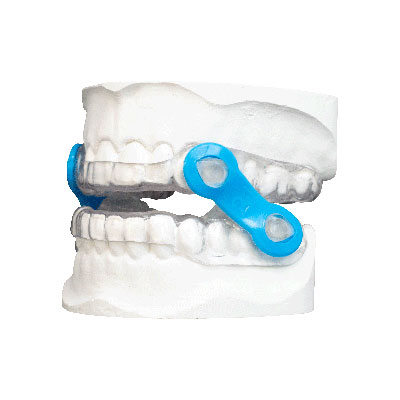
Treatment for Obstructive Sleep Apnea
Sleep disordered breathing, or obstructive sleep apnea (OSA) is a condition that causes the body to stop breathing several times during sleep.
After your body goes into a deep sleep, your muscles, skin, soft tissue and joints become very relaxed. For OSA patients, the relaxed state of the facial and throat muscles also causes the tissues in the upper airway to become loose and sag.
The Dangerous Obstructive Sleep Apnea Cycle
As moving air passes through the airway, the drooping soft tissue vibrates; this creates the sound of snoring.
When the airway becomes fully blocked, the body stops breathing until the brain tells it to wake up. The OSA cycle is repeated several times during the night.
Loud, heavy snoring followed by gasping or snorting for air is a classic sign of obstructive sleep apnea.
OSA is a serious health issue that can increase the risk of high blood pressure, heart disease, diabetes and other illnesses. Learn more about the health risks of obstructive sleep apnea.
Classification of Obstructive Sleep Apnea
Obstructive Sleep Apnea (OSA) is categorized as mild, moderate or severe. Following a sleep study and testing, the sleep specialist will prescribe treatment based on the severity of OSA, with consideration given to overall physical health and medications. Learn how Sleep Apnea is diagnosed.

What Treatment is available for Obstructive Sleep Apnea?
CPAP - Continuous Positive Airway Pressure Therapy
A primary objective for treatment of obstructive sleep apnea (OSA) is supporting the airway during sleep to prevent blockage and allow proper air flow. For moderate to severe cases of obstructive sleep apnea, the standard treatment is Continuous Positive Airway Pressure (CPAP) therapy.
Patients undergoing CPAP therapy wear a face mask that is connected by a hose to a pressurized air machine while they sleep. The CPAP system does not replace breathing or supply oxygen; instead, CPAP provides a steady flow of pressurized air across the throat soft tissues to keep them from drooping and blocking the airway as the body relaxes.
Because the airway stays open, CPAP therapy can also greatly reduce or eliminate snoring.
Patients with severe cases of OSA or lung illnesses like COPD (chronic obstructive pulmonary disease) may also use an oxygen supply device with CPAP.
There are a number of CPAP devices designed to provide different types of air pressure based on the patient’s specific needs, as well as a variety of mask options to achieve proper fit and comfort.
CPAP Benefits & Challenges
CPAP is considered to be a highly effective treatment for patients that use the system every night. While each person is different, most patients feel better after just a few days of using CPAP.
The key to improving sleep health with CPAP is consistency. While CPAP is the ‘gold standard’ therapy for treatment of obstructive sleep apnea, falling asleep and staying asleep while wearing the CPAP mask connected to the air unit can be a big adjustment. Patients that travel frequently often struggle to manage the cumbersome CPAP equipment and are not able to use it regularly.
CPAP Intolerance
Some patients are unable to tolerate CPAP altogether due to discomfort with the mask and equipment. Physical side effects from breathing pressurized air (morning dizziness, headaches, dry nasal passages and throat) can sometimes occur with CPAP therapy. Side effects can often be addressed by adjusting the CPAP equipment settings; however, some patients stop using CPAP completely due to unbearable side effects.
The sleep physician will work with the CPAP intolerant patient to explore OSA treatment options and alternatives to CPAP to find an approach that improves both physical health and sleep quality. Learn more about alternatives to CPAP therapy.
Airway Management with Oral Appliance Therapy (OAT)
Oral Appliance Therapy (OAT) is an integrative medical-dental treatment approach for obstructive sleep apnea. The sleep physician works closely with a dentist trained in dental sleep medicine to design a custom oral appliance for airway support during sleep.
Macon TMJ & Sleep Dentist Dr. Leigh Bennett has completed advanced clinical training in dental sleep medicine. Dr. Bennett works closely with sleep physicians in the middle Georgia community to provide oral appliance therapy services for treatment of obstructive sleep apnea.

Image courtesy of True Function Laboratory
A sleep apnea oral appliance is specifically designed to address airway issues. Some are designed to shift the lower jaw forward, which helps to keep the airway open while sleeping. If the tongue drops back into the throat during sleep, the appliance can be customized to prevent this from happening.
Oral sleep appliances may be used alone for mild cases of obstructive sleep apnea or as an alternative treatment for OSA patients that are CPAP intolerant. Oral appliance therapy can also be used in conjunction with CPAP for moderate to severe OSA cases.
Learn more about Oral Appliance Therapy services provided by sleep dentist Dr. Leigh Bennett at Hartley Bridge TMJ & Dental Sleep Center in Macon, Georgia.
Lifestyle Changes and Weight Loss
Based on the findings of your sleep study, your doctor may adjust your medications or recommend lifestyle changes to help the upper airway and respiratory system function more efficiently. Quitting smoking, losing weight and reducing alcohol use are common recommendations for OSA patients.
Positional Therapy
Some OSA patients can be assisted by adjusting their sleep position from lying on their back to sleeping on their side. When we lie on our back, simple gravity causes the airway soft tissues and tongue to fall back; for OSA patients, this can contribute to the airway becoming narrow or obstructed. The sleep physician may recommend a special pillow or other aids to help the OSA patient maintain a side sleeping position and prevent airway obstruction.
CPAP Alternatives
For patients with mild to moderate OSA, it may be possible to combine an oral sleep appliance with lifestyle changes, medications and positional therapy as an alternative to CPAP. Learn more about CPAP Alternatives.
Surgery for Treatment of Obstructive Sleep Apnea
Obstructive sleep apnea is linked to throat and nasal tissues that block the airway during sleep, causing the patient to stop breathing. For some OSA patients, surgery is necessary to alter these physical structures.
The sleep physician may recommend removal of tonsils and adenoids, or procedures to change the size and shape of the nasal passages (septoplasty) to assist with treatment of OSA. Other types of sleep apnea surgery may require modification of the throat muscles or removal of a section of tissue from the soft palate or the uvula (the tissue triangle that hangs in the back of the throat).
Sleep apnea surgery is a careful consideration for sleep specialists; non-surgical treatment is the first course of action for obstructive sleep apnea unless there are conditions that cannot be managed without surgical intervention.
Contact Hartley Bridge TMJ & Dental Sleep Center
Obstructive sleep apnea is a complex and life-threatening illness. If you have questions about snoring symptoms or sleep breathing disorders, please Contact our Sleep Dentist Dr. Leigh Bennett for more information and a referral to a local sleep physician in Macon.